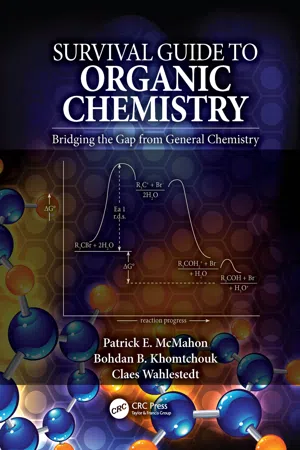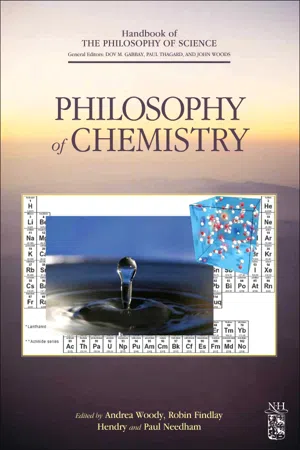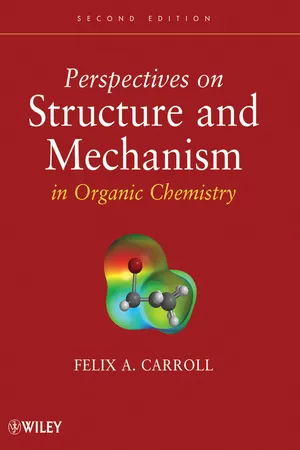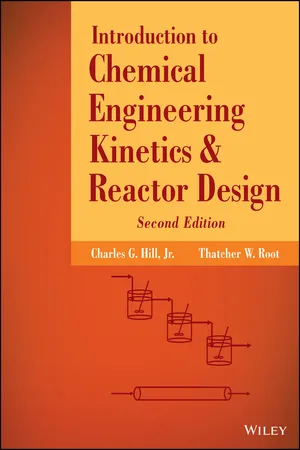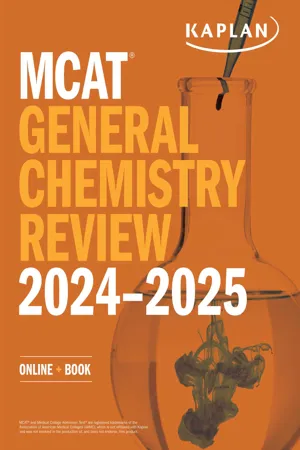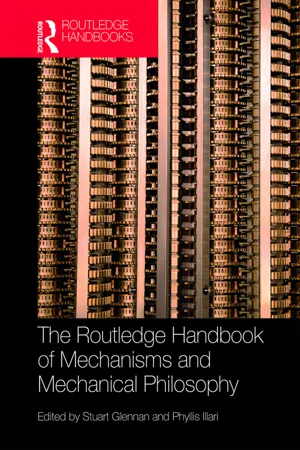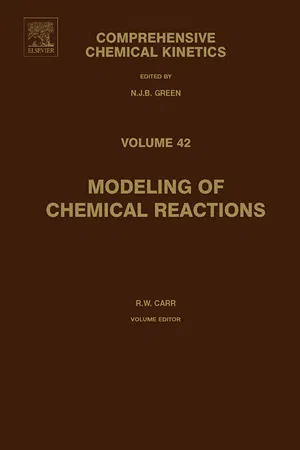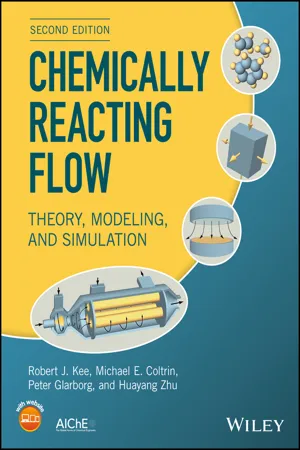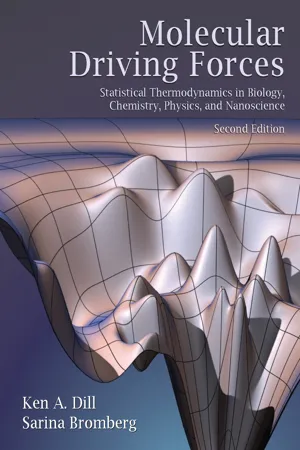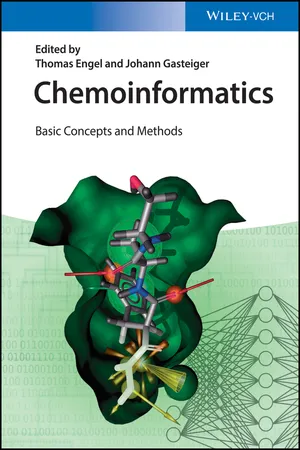Chemistry
Reaction Mechanism
A reaction mechanism is a step-by-step description of how chemical reactions occur at the molecular level. It outlines the sequence of individual chemical events that lead to the overall transformation of reactants into products. Understanding reaction mechanisms is crucial for predicting and controlling chemical reactions, as well as for designing new chemical processes and synthesizing new compounds.
Written by Perlego with AI-assistance
Related key terms
Related key terms
1 of 4
Related key terms
1 of 3
11 Key excerpts on "Reaction Mechanism"
- eBook - ePub
Survival Guide to Organic Chemistry
Bridging the Gap from General Chemistry
- Patrick E. McMahon, Bohdan B. Khomtchouk, Claes Wahlestedt(Authors)
- 2016(Publication Date)
- CRC Press(Publisher)
Guide to Kineticsand ReactionMechanisms9
9.1 GENERAL CONCEPTS
9.1.1 Reaction MechanismS
- A Reaction Mechanism is an accepted sequence of elementary reaction steps which describe all (based on available information) bond-making and bond-breaking events characterizing the change of reactant molecules to product molecules.
- A reaction step (or elementary step) is the smallest observable change in molecular bonding, an individual bond-making, bond-breaking , or combination event (simultaneous bond-making and bond-breaking) that can be distinguished experimentally from other such events.
- The complete Reaction Mechanism may be composed of only one step or many steps depending on the overall (complete) reaction and the conditions.
- A Reaction Mechanism, along with the parameters that describe it such as rate, activation energies, and intermediates (described in other sections) is a path function . A path function is dependent on the “pathway” or method by which a change occurs. Regardless of the numerical value or sign of the free energy change, a reaction can occur only if there exists an available pathway by which reactant molecules can be converted into product molecules.
- Path functions must be distinguished from state functions such as ΔG, ΔH, and ΔS. These depend only on the initial and final states of the system: the total energies of the reactants versus the products. State functions do not depend on how the reaction changes occur.
- All reactants and products in a complete reaction or in a single reaction step must exist as an independent species for some measurable amount of time. This existence is due to the presence of energy barriers blocking “instant” decomposition. The compound is considered to be in a “potential energy well” (i.e., a stable energy “valley” similar to a rock sitting in a hole) termed a local energy minimum . A “deep” hole represents a very stable molecule (slow to react) because the energy barriers on each side are high. A “shallow” hole represents a relatively
- eBook - ePub
- Dov M. Gabbay, Paul Thagard, John Woods(Authors)
- 2011(Publication Date)
- North Holland(Publisher)
Gould, 1959 , p. 127]. This is what one might expect, given the explanation above of why thin mechanisms suffice for developing an understanding of organic chemistry. Second, these mechanisms break a chemical reaction down into a sequence of steps. For instance, Lowry and Richardson say: “A Reaction Mechanism is a specification, by means of a sequence of elementary chemical steps, of the detailed process by which a chemical change occurs” [Lowry and Richardson, 1987, p. 190]. These two features of mechanisms are related and both are important to the role of mechanisms in understanding chemical reactions.Providing information about the important intermediate structures in a transformation, such as the transition state or stable intermediates, allows the organic chemist to perform structural analysis of the relative energies of these intermediates. A structural analysis, in turn, enables one to predict or explain relative energy differences between structures based on a small set of robustly applicable and easily recognizable structural features. These relative energy differences can then, with the aid of the standard theoretical models of chemical transitions, be used to infer important empirically measurable features of chemical reactions such as relative rates or product distributions. 7 In this way, structural analyses of the relative energy differences between important intermediates in the course of a chemical transformation are the modern realization of Butlerov's goal to explain all the chemical properties of substances on the basis of their chemical structures. 8 - No longer available |Learn more
- Felix A. Carroll(Author)
- 2011(Publication Date)
- Wiley(Publisher)
CHAPTER 6 Methods of Studying Organic Reactions 6.1 MOLECULAR CHANGE AND Reaction MechanismSA Reaction Mechanism is a step-by-step description of a chemical transformation at the molecular level that gives information about the location of all nuclei and electrons, including those of solvent and other species present, as well as the total energy of the system. Gould called a mechanism a motion picture of the chemical transformation—one that we can stop and analyze frame by frame.1 Such a motion picture should be viewed as a simulation, however. We cannot see the molecular events; we can only depict what we infer them to be.The methods that we use to study mechanisms are never conclusive but are only indicative. That is, a mechanism can be disproved, but it can never be proved. 2 A mechanism may become established, which means that it is the only proposed mechanism that is able to predict the results of experiments designed to test possible mechanisms. Scientists are always open to the possibility that new data will conflict with current thinking, so they treat mechanisms as more or less thoroughly tested models and not as timeless realities.6.2 METHODS TO DETERMINE Reaction MechanismS Identification of Reaction ProductsThe most fundamental step in any investigation of a chemical reaction is the determination of the products of the reaction.3 This might appear to be a trivial statement, but it is not. Consider the study of the reaction of benzyl chloride (1) with hydroxide to give benzyl alcohol (2). One way to study the mechanism of the reaction is to determine what effect substituents on the benzene ring have on the rate constant for the reaction. Therefore, one might first determine the kinetics of the reaction of benzyl chloride with hydroxide ion and then determine the kinetics of the reactions of hydroxide with a series of substituted benzyl chlorides, including p-nitrobenzyl chloride (3). The product of the reaction of 3 is 4,4′-dinitrostilbene (4), however, not p -nitrobenzyl alcohol.4 Obviously, kinetic studies or other mechanistic investigation of all of the reactions cannot be interpreted in terms of one uniform mechanistic pattern if different reactants give different products.1 - Charles G. Hill, Thatcher W. Root(Authors)
- 2014(Publication Date)
- Wiley(Publisher)
There are at least two levels of sophistication at which one may approach the problem of providing a molecular description of the phenomena that occur during the course of a chemical reaction. At the first level the sequence of molecular events is described in terms of the number and type of molecules and molecular fragments that come together and react in the various steps. The second level of description contains all of the elements of the first but goes beyond it to treat the geometric and electronic configurations of the various species during the different stages of the reaction sequence. For this book, the first level of description is adequate. The second level is more appropriate for study in courses involving physical organic chemistry or advanced physical chemistry.The mechanism of a reaction is a hypothetical construct. It is a provisional statement based on available experimental data, representing a suggestion as to the sequence of molecular events that occur in proceeding from reactants to products. It does not necessarily represent the actual events that occur during the reaction process, but it must be consistent with the available experimental facts. Often, there will be more than one mechanism that is consistent with these facts. The problem of designing an experiment that will eliminate one or more of the competing mechanisms is a challenging problem for the kineticist. In some cases it is an impossible task.Implicit in the use of the term sequence of molecular events is the idea that the chemical transformation that one observes in the laboratory is not the result of a single molecular process but is the end result of a number of such processes. If one considers reactions such as4.0.14.0.2it should be evident from a purely statistical viewpoint that there is virtually zero probability that the number of molecular species involved in these reactions would simultaneously be in spatial and electronic configurations such that more than a few chemical bonds could be broken and/or made in a single step. These equations merely describe the stoichiometry that is observed in the laboratory. Nonetheless, they do reflect the conversion of reactant molecules into product molecules. It is quite plausible to assume that the events that occur on a molecular level are encounters at which atomic rearrangements occur and that the reaction observed may be interpreted as the sum total of the changes that occur during a number of such encounters. This assumption is the foundation on which all studies of Reaction Mechanisms are based. The major justifications for its use lie in the tremendous success it has had in providing a molecular interpretation of kinetic phenomena and the fact that it has been possible to experimentally observe some of the intermediates postulated in sequences of elementary reactions.- No longer available |Learn more
MCAT General Chemistry Review 2024-2025
Online + Book
- (Author)
- 2023(Publication Date)
- Kaplan Test Prep(Publisher)
mechanism of a reaction, and the sum of which gives the overall reaction. Knowing the accepted mechanism of a reaction may help explain the reaction’s rate, position of equilibrium, and thermodynamic characteristics. Consider this generic reaction:A2 + 2 B → 2 ABBRIDGE
Mechanisms are proposed pathways for a reaction that must coincide with rate data information from experimental observation. Reaction Mechanisms are a major topic in organic chemistry and metabolism; Chapters 5 through 10 of MCAT Organic Chemistry Review and Chapters 9 through 11 of MCAT Biochemistry Review focus almost exclusively on Reaction Mechanisms in specific contexts.On its own, this equation seems to imply a mechanism in which two molecules of B collide with one molecule of A2 to form two molecules of AB. Suppose instead, however, that the reaction actually takes place in two steps:Step 1: A2 + B → A2 B (slow) Step 2: A2 B + B → 2 AB (fast) Note that the two steps, taken together, give the overall net reaction. The molecule A2 B, which does not appear in the overall reaction, is called an intermediate. Reaction intermediates are often difficult to detect because they may be consumed almost immediately after they are formed, but a proposed mechanism that includes intermediates can be supported through kinetic experiments. One of the most important points to remember is that the slowest step in any proposed mechanism is called the rate-determining step because it acts like a kinetic bottleneck, preventing the overall reaction from proceeding any faster than that slowest step.KEY CONCEPT
The rate of the whole reaction is only as fast as the rate-determining step.Molecular Basis of Chemical Reactions
It’s one thing to say A2 reacts with 2 B to form 2 AB; it’s quite another to be able to describe, as precisely as possible, the actual interactions that occur between A2 - eBook - ePub
Chemistry
With Inorganic Qualitative Analysis
- Therald Moeller(Author)
- 2012(Publication Date)
- Academic Press(Publisher)
might take place in two stepsthe study of reaction rates and Reaction Mechanisms. Knowing the rate of a chemical reaction and the effect on the reaction rate of conditions such as temperature and pressure allows us to predict how fast a reaction will reach equilibrium. And reaction rate studies often give us greater understanding of the exact pathway from reactants to products-the Reaction Mechanism. This pathway is not always what it appears to be from the equation. For example, the overall reactioninvolving an intermediate I that is used up as fast as it is formed and is therefore never observed. These two steps together are the Reaction Mechanism of the overall reaction .Knowledge is power, as the saying goes, and the more chemists or chemical engineers know about the equilibria, rates, and mechanisms of reactions, the better they can control events to produce the products they want in desirable quantities under economically attractive conditions.How reactions take place
15.1 Collision theory
Chemical reactions take place by the transfer of electrons from one atom to another or by a change in the way electrons are shared. For this transfer or sharing to occur the atoms involved must be in contact. It has already been pointed out that atoms and molecules are in constant motion and that there are frequent collisions between them. This is especially apparent in the gaseous and liquid states, but it is true of the solid state, too.The collision theory - Stuart Glennan, Phyllis Illari, Stuart Glennan, Phyllis Illari(Authors)
- 2017(Publication Date)
- Routledge(Publisher)
6. ConclusionAttempts to explain the relative rates of chemical reactions initially led chemists to introduce a new theoretical tool—the Reaction Mechanism. Initially, these were decompositions of a chemical reaction into sequential steps containing hypothetical intermediates. Eventually, facilitated by developments in theories of chemical bonding and reaction rates, chemists moved inside these elementary steps, describing the transitory structures theoretically relevant to the rates of chemical reactions. With this move, the explanatory power of the Reaction Mechanism dramatically increased. Structural features of the products of the most important types of reaction in organic chemistry were now explicable in mechanistic, and therefore structural, terms. Furthermore, this new mechanistic understanding could be leveraged to facilitate the rational planning of novel chemical syntheses, and this has always been the coin of the realm for the organic chemist.12Notes1 See Goodwin (forthcoming) for an account of structural formulas as the primary models of organic chemistry.2 The reaction coordinate is the lowest-energy path from reactant to products, over the course of which some bonds in the reactants are broken, while new bonds in the product are formed. The highest-energy point along this path is called the transition state.3 Bartlett (1956, pp. 9–10) says, “If in any organic reaction one could write reliable structural formulas for the n intermediates and the n + 1 transition states, the problem of its mechanism might be considered solved.”4 See Goodwin (forthcoming) for the roles of models in chemistry.5 See Hammett (1940, pp. 96–9) for an account of Lapworth’s reasoning as applied to the halogenation of ketones.6- eBook - ePub
- R.W. Carr(Author)
- 2007(Publication Date)
- Elsevier Science(Publisher)
Fig. 1 , we have also reached the end of the present chapter. Although many details of the individual steps have, by necessity, been omitted, we hope that the overall procedure to be followed is clear and that, in combination with the more detailed treatment of various steps in the process that have been provided in earlier chapters of this text, it provides a clear path to the rational construction of detailed mechanisms of elementary chemical reactions. Detailed chemical kinetic modeling has already demonstrated its potential in a number of applications, including combustion, atmospheric chemistry, hydrocarbon pyrolysis, and a number of vapor-phase materials processing systems. In the earliest and most technologically important of these application areas, Reaction Mechanisms have evolved over several decades with the support of extensive experimental measurements of species thermochemistry and the kinetics of elementary reactions. In this regard, our predecessors have already traversed much of the steep slope of the learning curve in this field. In recent years, increasingly powerful computational tools for predicting reaction thermochemistry and kinetics, along with the still-growing database of experimental results, have dramatically shortened the time required to develop relatively complete mechanisms of elementary reactions to describe some new overall vapor-phase transformation. This, in turn, makes it increasingly possible to apply detailed chemical kinetic modeling to new problems in propulsion, vapor-phase materials processing, and other applications.However, the construction and analysis of Reaction Mechanisms remain far from being a fully automated or automatable process. As seen throughout this chapter, there are many points where educated guessing and chemical intuition enter the process and, therefore, where the results are highly dependent on the practitioner who produces them. Importantly, the construction of detailed mechanisms of elementary reactions is only a tractable problem in the gas phase, where reactions occur among isolated molecules and, with more difficulty, at gas–solid interfaces. In principle, the same approaches to Reaction Mechanism development and analysis are applicable in solution, and even in biological systems. However, in solution the parameter spaces are much larger, with reaction rates that depend on solvent composition, and both species thermochemistry (in non-ideal mixtures) and reaction rate parameters are much more difficult to compute. In biological systems, the situation is much more complicated yet, since the environment is often inhomogeneous. Nevertheless, the extension of detailed chemical kinetic modeling to condensed phase and biological systems represents perhaps the most important opportunity to increase the impact of such approaches. Such extensions, along with improved methods of automating the mechanism generation process, improved computational predictions of species thermochemistry and reaction kinetics, and more efficient incorporation of detailed kinetics into multi-dimensional models of physical systems, are important steps to expanding the applicability, reliability, and impact of detailed chemical kinetic modeling. - eBook - ePub
Chemically Reacting Flow
Theory, Modeling, and Simulation
- Robert J. Kee, Michael E. Coltrin, Peter Glarborg, Huayang Zhu(Authors)
- 2017(Publication Date)
- Wiley(Publisher)
CHAPTER 14 Reaction MechanismSChapter 13 discussed the theory of elementary reactions. The chemical processes occurring in chemically reacting flows usually proceed by a series of elementary reactions, rather than by a single step. The collection of elementary reactions defining the chemical process is called the mechanism of the reaction. When rate constants are assigned to each of the elementary steps, a chemical kinetic model for the process has been developed.Using a chemical kinetic model is one way to describe the chemistry in reacting flow modeling. The chemical kinetic model offers a comprehensive description of the chemistry, but it requires a larger computational effort than simplified chemical models.The present chapter discusses the development and use of detailed Reaction Mechanisms in modeling reacting flows. Developing Reaction Mechanisms requires attention to some “collective aspects of mechanisms," such as the driving forces for gas-phase chemical processes and the characteristics and similarities of different reaction systems.For illustration, selected medium to high temperature gas-phase processes are discussed in some detail. Gas-phase reactions at elevated temperature are important in combustion, incineration, flue gas-cleaning, petrochemical processes, chemical synthesis, and materials production. Although the details of these systems may vary significantly, they share characteristics that are common for all gas-phase Reaction Mechanisms.14.1 Models for Chemistry
In chemically reacting flow systems, the overall reaction rate may be limited by the mixing rate of the reactants or by the rate of the chemical reaction upon mixing. If mixing is slow compared to chemical reaction, the system is diffusion or mixing controlled, while fast mixing and slow reaction results in a kinetically controlled system (Fig. 14.1 ).Figure 14.1 - eBook - ePub
Molecular Driving Forces
Statistical Thermodynamics in Biology, Chemistry, Physics, and Nanoscience
- Ken Dill, Sarina Bromberg(Authors)
- 2010(Publication Date)
- Garland Science(Publisher)
19 Chemical Kinetics & Transition States Chemical Reaction Rates Depend on TemperatureNow, we focus on the kinetics of chemical reactions. To predict how the rate of a chemical reaction depends on its molecular structures, you can use the same statistical thermodynamics approach that we used in Chapter 13 to model equilibria. Chemical reactions typically speed up more strongly with temperature than physical processes do. To understand this, you need one additional concept: the transition state or activation barrier.The Mass Action Laws Describe Mechanisms in Chemical KineticsConsider a chemical reaction in which a product P is produced from reactants A, B, and C, with stoichiometric coefficients a, b, and c:a A + b B + c C → P .(19.1) In general, the reaction rate depends on the concentrations of the reactants, the temperature and pressure, and the coefficients a, b, and c. Experiments often measure how reaction rates depend on the concentrations of the reactants. Such experiments can provide valuable information about the mechanism of the reaction.The kinetic law of mass action, first developed by CM Guldberg and P Waage in 1864, says that reaction rates should depend on stoichiometry in the same way that equilibrium constants do. According to this law, the initial rate of product formation, d[P]/dt for the reaction in Equation (19.1) , depends on the reactant concentrations:=d[ P ]d tk f[ A ]a[ B ]b,[ C ]c(19.2) where kf is the rate coefficient for the forward reaction. However, kinetic mechanisms often do not follow the thermodynamic stoichiometries. If a reaction is a single step, called an elementary reaction, then such expressions apply. The main types of elementary reactions are unimolecular decay of a molecule (a = 1, b = c = 0) or a bimolecular reaction when two molecules come together (a = b = 1, c = 0). However, chemical reactions typically involve multiple steps and kinetic intermediate states. For such non-elementary reactions, you cannot express the rate equation in such simple stoichiometric terms. At present, rate laws can only be determined from experiments. We do not address Reaction Mechanisms here; they are described in chemical kinetics textbooks such as [1 , 2 - eBook - ePub
Chemoinformatics
Basic Concepts and Methods
- Thomas Engel, Johann Gasteiger(Authors)
- 2018(Publication Date)
- Wiley-VCH(Publisher)
4 Representation of Chemical Reactions Oliver Sacher1 and Johann Gasteiger2 1 Molecular Networks GmbH, Neumeyerstraße 28, 90411 Nürnberg, Germany2 Computer‐Chemie‐Centrum, Universität Erlangen-Nürnberg, Nägelsbachstr. 25, 91052 Erlangen, GermanyOutline
- 4.1 Introduction
- 4.2 Reaction Equation
- 4.3 Reaction Types
- 4.4 Reaction Center and Reaction Mechanisms
- 4.5 Chemical Reactivity
- 4.6 Learning from Reaction Information
- 4.7 Building of Reaction Databases
- 4.8 Reaction Center Perception
- 4.9 Reaction Classification
- 4.10 Stereochemistry of Reactions
- 4.11 Reaction Networks
Learning Objectives
- To describe basic models of chemical reactivity.
- To apply simple approaches to quantify chemical reactivity.
- To extract knowledge from reaction information.
- To review reaction classification as an important step in learning from reaction instances.
- To locate the reaction center and its importance in reaction searching.
- To sketch some algorithmic approaches to reaction classification.
- To explain the formal treatment of the stereochemistry of reactions.
4.1 Introduction
Reactions represent the dynamic aspect of chemistry, the interconversion of chemical compounds. Chemical reactions produce the compounds that are sold by industry and that make up a large part of the standard of living of our society, they transform the food that we take up in our body into energy and into other compounds, they provide the energy for surviving in a hostile environment, and they deliver the energy for a large part of our transportation systems.In the laboratory, reactions are run under a variety of conditions, from making large collections of small amounts of compounds through parallel synthesis on well plates, through syntheses in standard three‐necked flasks, all the way to the large‐scale industrial processes in huge reactors. In a mass spectrometer, single molecules break up in the gas phase after ionization through electron impact; in a cell, genes control the synthesis of complex proteins.
Index pages curate the most relevant extracts from our library of academic textbooks. They’ve been created using an in-house natural language model (NLM), each adding context and meaning to key research topics.
Explore more topic indexes
Explore more topic indexes
1 of 6
Explore more topic indexes
1 of 4
